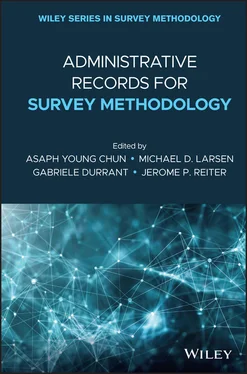1 ...7 8 9 11 12 13 ...25 The distinction between weighting and imputation can be somewhat blurred when it comes to the adjustment of cross-classified proxy contingency tables, because an adjusted cell count is just the number of individuals with the corresponding cross-classification one would have in an imputed dataset. Take, e.g. a two-way table, where the rows represent population domains at some detailed level, say, by local area and sex-age group, and the columns a composition of interest, say, income class. Let X denote the table based on combining population and tax register data. Let Y (r)denote the known vector of population domain sizes, and let  denote the survey-based estimates of population totals by income class, which are the row and column benchmarks of the target table Y , respectively. Starting with X and by means of iterative proportional fitting (IPF) until convergence, one may obtain a table
denote the survey-based estimates of population totals by income class, which are the row and column benchmarks of the target table Y , respectively. Starting with X and by means of iterative proportional fitting (IPF) until convergence, one may obtain a table  that sums to both Y (r)and
that sums to both Y (r)and  marginally. The technique has many applications including small area estimation (Purcell and Kish 1980) and statistical matching (D’Orazio, Di Zio, and Scanu 2006; Zhang 2015a) – more in Section 1.3.2.
marginally. The technique has many applications including small area estimation (Purcell and Kish 1980) and statistical matching (D’Orazio, Di Zio, and Scanu 2006; Zhang 2015a) – more in Section 1.3.2.
A key difference between the asymmetric-linked setting and the asymmetric-unlinked setting discussed above is that, one generally does not expect a benchmarked adjustment method based on unlinked data to yield unbiased results below the level where the benchmarks are imposed. For instance, repeated weighting of Renssen and Nieuwenbroek (1997) can yield design-consistent domain estimates subjected to population benchmark totals, because the overlapping survey variables are both considered as the target measure here and no relevance bias is admitted. However, when the same technique is applied to reweight a register dataset, e.g. with the initial weights all set to 1, one cannot generally claim design or model-based consistency below the level of the imposed benchmarks, regardless of whether the benchmarks themselves are true or unbiased from either the design- or model-based perspective. Similarly, provided suitable assumptions, the one-number census imputation can yield model-consistent estimates below the level of the imposed constraints, because the donor records are taken from the enumerated census records that are considered to provide the target measures. However, the model-consistency would fall apart when the donor pool is a register dataset that suffers from relevance bias, even if all the other “suitable” assumptions are retained. Assessment of the statistical uncertainty associated with benchmarked adjustment is therefore an important research topic. An illustration in the contingency table case will now be given in Section 1.3.2.
1.3.2 Uncertainty Evaluation: A Case of Two-Way Data
Let a = 1, …, A and j = 1, …, J form a two-way classification of interest. For example, a may stand for ethnicity (White, Black, and Others), and j election votes for party (Democratic, Republic, Others). Or, let a be the index of a large number of local areas, and j the different household types such as single-person, couple without children, couple with children, etc. Let X = { X aj} be a known register-based proxy table that is unacceptable as “direct tabulation” of the target table Y = { Y aj}.
For the asymmetric-linked setting, suppose there is available an observed sample two-way classification of ( a , j ). For survey weighting, let s denote the sample and let d i= 1/π ibe the sampling weight of unit i ∈ s , where π iis the inclusion probability. Let y i( a , j ) = 1 if sample unit i ∈ s has classification ( a , j ) according to the target measure and y i( a , j ) = 0 otherwise; let x i( a , j ) = 1 if it has classification ( a , j ) according to the proxy measure and x i( a , j ) = 0 otherwise. Post-stratification with respect to X yields then the poststratification weight, say,  , where
, where 
This is problematic when there are empty and very small sample cells of ( a , j ). Raking ratio weight can then be given by  , where
, where  is derived by the IPF of
is derived by the IPF of  to row and column totals X a+and X +j, respectively. Deville, Särndal, and Sautory (1993) provide approximate variance of the raking ratio estimator, say,
to row and column totals X a+and X +j, respectively. Deville, Särndal, and Sautory (1993) provide approximate variance of the raking ratio estimator, say,  where
where 
A drawback of the weighting approach above is that no estimate of Y ajwill be available in the case of empty sample cell ( a , j ), and the estimate will have a large sampling variance when the sample cell ( a , j ) is small in size. This is typically the situation in small area estimation, where, e.g. a is the index of a large number of local areas. Zhang and Chambers (2004) and Luna-Hernández (2016) develop prediction modeling approach.
The within-area composition ( Y a1, Y a2, …, Y aJ) is related to the corresponding proxy composition ( X a1, X a2, …, X aJ) by means of a structural equation

where  is the area-vector of interactions on the log scale, i.e.
is the area-vector of interactions on the log scale, i.e.  where
where  =
=  , and similarly for
, and similarly for  , and βa matrix of unknown coefficients that sum to zero by row and by column.
, and βa matrix of unknown coefficients that sum to zero by row and by column.
Читать дальше

 denote the survey-based estimates of population totals by income class, which are the row and column benchmarks of the target table Y , respectively. Starting with X and by means of iterative proportional fitting (IPF) until convergence, one may obtain a table
denote the survey-based estimates of population totals by income class, which are the row and column benchmarks of the target table Y , respectively. Starting with X and by means of iterative proportional fitting (IPF) until convergence, one may obtain a table  that sums to both Y (r)and
that sums to both Y (r)and  marginally. The technique has many applications including small area estimation (Purcell and Kish 1980) and statistical matching (D’Orazio, Di Zio, and Scanu 2006; Zhang 2015a) – more in Section 1.3.2.
marginally. The technique has many applications including small area estimation (Purcell and Kish 1980) and statistical matching (D’Orazio, Di Zio, and Scanu 2006; Zhang 2015a) – more in Section 1.3.2. , where
, where 
 , where
, where  is derived by the IPF of
is derived by the IPF of  to row and column totals X a+and X +j, respectively. Deville, Särndal, and Sautory (1993) provide approximate variance of the raking ratio estimator, say,
to row and column totals X a+and X +j, respectively. Deville, Särndal, and Sautory (1993) provide approximate variance of the raking ratio estimator, say,  where
where 

 is the area-vector of interactions on the log scale, i.e.
is the area-vector of interactions on the log scale, i.e.  where
where  =
=  , and similarly for
, and similarly for  , and βa matrix of unknown coefficients that sum to zero by row and by column.
, and βa matrix of unknown coefficients that sum to zero by row and by column.










